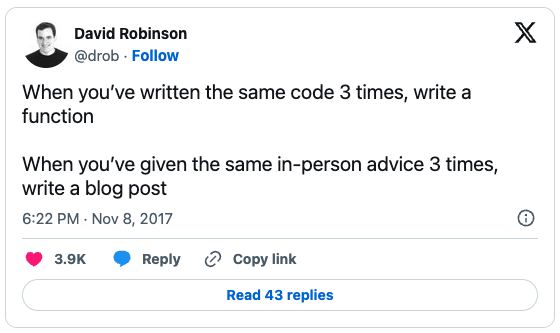
A still-very-relevant tweet by David Robinson
Anticipated deliverable(s)
By the end of today’s class, you should have:
- a draft of your first data science blog post
Pre-class Prep
Please be sure to complete the following before class:
A. Add potential blog post topics / ideas to your personal branding guide (part VII)
Coming up with topics to blog about can feel intimidating (especially in the beginning), however your personal branding guide can help to steer you in a productive direction. Recall that your personal brand shapes how you present yourself, not only in your aesthetic choices, but also the types of content you choose to publish and the tone you use throughout.
- Cédric Scherer’s blog is one of the first places I turn to when I’m looking for data viz /
{ggplot2}content - Crystal Lewis’ blog features lots of tutorials and conversations about data management practices
- Danielle Navarro’s blog largely chronicles her experiences learning new tools and creating generative art
NOTE: You (most likely) will not have your brand identity fully sorted and solidified by this point (and that’s perfectly okay!). The above examples are meant to show how working towards finding your brand can (over time) help build a pattern of trust that draws visitors back to your website in search of familiar content.
Review your personal branding guide and jot down some (2-4, or more if you want!) potential blog post ideas / topics that fit your brand identity (part VII; refer back to the template, if necessary). Be prepared to select one of your ideas during class, where you’ll begin to actually draft your first blog post. Consider the following:
- What do your personal branding adjectives and key messages say about you and your interests?
- What topics blend your current interests and expertise with your future learning goals?
- What might draw someone to your website over a different website? Consider how your brand can help to define your niche.
- Not all data science blog posts need to be technical (e.g. include example code) – reflections and commentary on different aspects of your data science journey can be equally as valuable.
- Ultimately, you should be choosing something you’re excited to write about (it can be easier to engage a reader when you yourself are jazzed about the topic)!
- Important: Consider topics that you can feasibly write a blog post on by the end of this course (week 6) – you may also add larger-scoped or more involved topic ideas to your personal branding guide to return to in the future
- how your past professional or personal interests led you to pursue a degree in environmental data science
- non-data science skills / experiences that you’ve found to be transferable to your data science learning journey (in perhaps surprising / unexpected ways)
- advice you wish you had before beginning a data science graduate program
- writing a data product-focused MEDS Capstone or MESM Group Project proposal
- reflecting on the MEDS 6-week summer coding bootcamp
- your journey towards discovering your personal brand identity / building your website(!)
- what early data science skills you’ve found most valuable or surprising (so far), and why
- a mini tutorial on a focused data science skill / topic, e.g.
- how a particular function(s) or package has helped you overcome a data challenge, and why / how
- a data science workflow or organizational procedure you’ve adopted, and why
- building a data visualization or other creative product
It’s still valuable (and important) to think about how your framing, tone, and focus within each of these suggested topic areas fits your brand identity.
B. (Optional) Check out some data science-y blog posts
Reading other data science blogs is the best way to get a sense of not only the breadth of topics that folks in the community are writing about, but also the tone, writing styles, and creative approaches you might take as a blogger. We’ll discuss some example blog posts during class, though you should feel free to explore ahead of time, if you’re eager:
A handful of posts to showcase some different writing styles and topics areas:
- An introduction to Python for R Users, by Rebecca Barter
- My first live coding interview, by Maya Gans
- Notes from live code review of
{soils}, by Jadey Ryan - Creating typewriter-styled maps in
{ggplot2}, by Nicola Rennie - Porting the Openscapes website from blogdown to Quarto, by Sam Csik
- Generative art with grid, by Danielle Navarro
- Slidecrafting 101: Layout, by Emil Hvitfeldt
And a few additional fun blogs to keep an eye on:
- Meghan Hall
- Meghan Harris
- Crystal Lewis
- Cosima Meyer
- Beatriz Milz
- Shannon Pileggi
- Albert Rapp
- Nicola Rennie
- Cédric Scherer
- Cara Thompson
- Nick Tierney
- Isabella Velásquez
- rostrum.blog (by Matt Dray and Adriana De Palma)
This is only a small sampling of the many rad data science bloggers out there – if you stumble upon others that you enjoy, be sure to share them in the class Slack channel!
Lecture Materials
Follow along with these slides as we brainstorm our first data science blog posts:
What should I continue working on?
- Seek feedback on your draft / plan from others. Consider switching blog post drafts with one (or more) of your peers, or stick around for office hours to chat with me about your ideas!
- Continue drafting, writing, and polishing your blog post. You (most likely) won’t have a fully-written blog post by the end of class today, but you should plan to complete and publish your post by the end of this course (week 6).
(Optional) Lunch with an NCEAS Data Scientist
There is no lunch today!